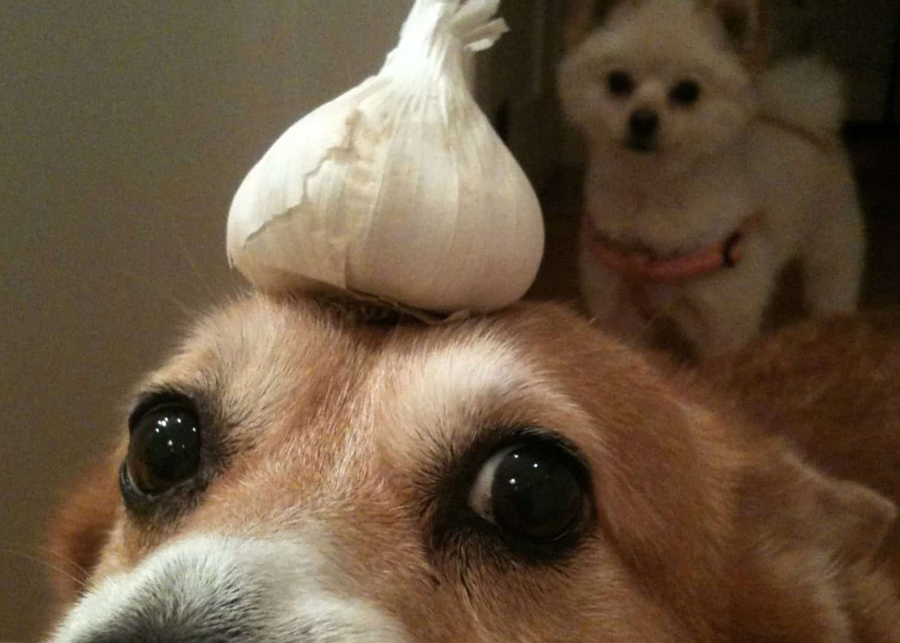On occasions, we like to spice up our foods with some garlic. It adds a certain flavor and aroma that we simply cannot do without. Garlic is a part of our daily lives, but the question we need to ask ourselves is what would happen when our four-legged family members have access to it? Can dogs eat garlic?
Have you ever wondered if you can give your dog garlic? It is one of the most popular vegetables for humans and can be used in cooking. However, it can be dangerous for dogs. In this article, we’ll look at the symptoms of garlic toxicity, how to treat it, and how to keep your dog from being effected by garlic. Read on to learn more! * Are you sure you want to give your dog garlic?

Why cant dogs eat Garlic
Despite the delicious flavor, garlic is harmful for dogs. It contains toxins and can cause digestive problems. In humans, garlic is beneficial for lowering cholesterol, preventing heart disease, and boosting the immune system. It can also fight the common cold. Garlic is a member of the allium plant family, along with onions, chives, and leeks. However, dogs should not eat it, even in small amounts.
When dogs ingest garlic, they can end up with hemolytic anemia. This is because there is not enough oxygen being carried throughout the body. Symptoms of garlic poisoning can develop rapidly, and dogs should seek medical attention immediately. Garlic poisoning is most common in Japanese dogs, which have a higher red blood cell count and lower levels of potassium. It can also cause respiratory problems. But the best way to protect your dog from garlic poisoning is to keep it away from it completely.
Why is Garlic Toxic to Dogs?
Many people are concerned about the possible side effects of garlic for dogs. Fortunately, it is not harmful in small amounts. However, the garlic plant contains a number of compounds that can be harmful to dogs. These compounds include thiosulfates, which can cause intestinal upset and drooling. The compounds in garlic can also damage the dog’s red blood cells, which can lead to anemia.
The most important treatment for a dog suffering from garlic poisoning is to induce vomiting. The veterinarian may prescribe activated charcoal, which binds to the poison and aids in detoxification. If the symptoms persist, the veterinarian may suggest hospitalization. Serious cases may require blood transfusion. A veterinary appointment is recommended if your dog experiences vomiting, abdominal pain, or diarrhea. The underlying cause of garlic toxicity is not known.
Symptoms of Garlic Toxicity
Symptoms of garlic toxicity for dogs include lethargy and anemia. The gums and inner eyelids may also be pale. Your dog will likely become lethargic and weak. Your dog’s heart rate and breathing will also increase. Garlic contains compounds that relax heart muscles and widen blood vessels. This process lowers blood pressure and raises heart rate. It also makes the heart pump harder.
If your dog has eaten too much garlic, take it to a veterinarian immediately. The toxicity can be fatal for your dog, but the vast majority of cases can be treated with supportive care and medications. Your dog may vomit or exhibit other symptoms. A veterinary exam may reveal additional signs of garlic toxicity and help you treat your
dog quickly. Depending on the severity of your dog’s condition, your veterinarian may recommend a course of treatment.
Treatment of Garlic Toxicity in Dogs
There are several treatment options for garlic toxicity in dogs. The first step is to induce vomiting. Then, activated charcoal can be administered, which binds to the poison and helps in detoxification. If the condition worsens, the veterinarian may consider admitting the dog to the hospital for further treatment. If the dog’s condition has deteriorated to the point of anemia, the veterinarian may recommend a blood transfusion.
The treatment of garlic toxicity in dogs depends on the severity and duration of the poisoning. If the poisoning is severe, a vet will likely administer medication that causes vomiting. This will prevent garlic from getting into the bloodstream and preventing further damage. Alternatively, the veterinarian may administer activated charcoal, which will neutralize the garlic in the gastrointestinal tract. Depending on the severity of the condition, the treatment for garlic toxicity in dogs can include several different steps.

Safe Vegetable Alternatives
There are several vegetables that are safe substitutes for garlic that dogs can safely eat. Some of these vegetables include celery, broccoli, green beans, raspberries, and apples. Before giving your dog these vegetables, chop them into small pieces and consult with your veterinarian. All animals have different reactions to different foods. If your dog ingests garlic, symptoms of an allergic reaction may include vomiting, an increase in heart rate, and lethargy.
Onions and garlic are highly toxic for dogs and must be avoided. Although they taste delicious, these vegetables are packed with the harmful ingredient solanine, which can cause seizures and tremors in dogs. Although ripe tomatoes are usually safe for dogs, green tomatoes are highly toxic. Other vegetables that are toxic for dogs include eggplant. Eating raw eggplant can cause allergic reactions in some dogs. To avoid this, you should cook them before feeding your dog.
Can Dogs Eat Garlic? Result
Dogs can eat a small amount of garlic without problems. The cooked form is recommended, but giving it to them raw can lead to problems. For example, they may suffer some gastrointestinal issues. Also, they may develop diarrhea and have a reduced appetite due to this. Giving a dog too much of it can lead to some serious side effects such as seizures, loss of coordination, lethargy, and more. So, if you are going to give your dog garlic, keep in mind how much is too much.


